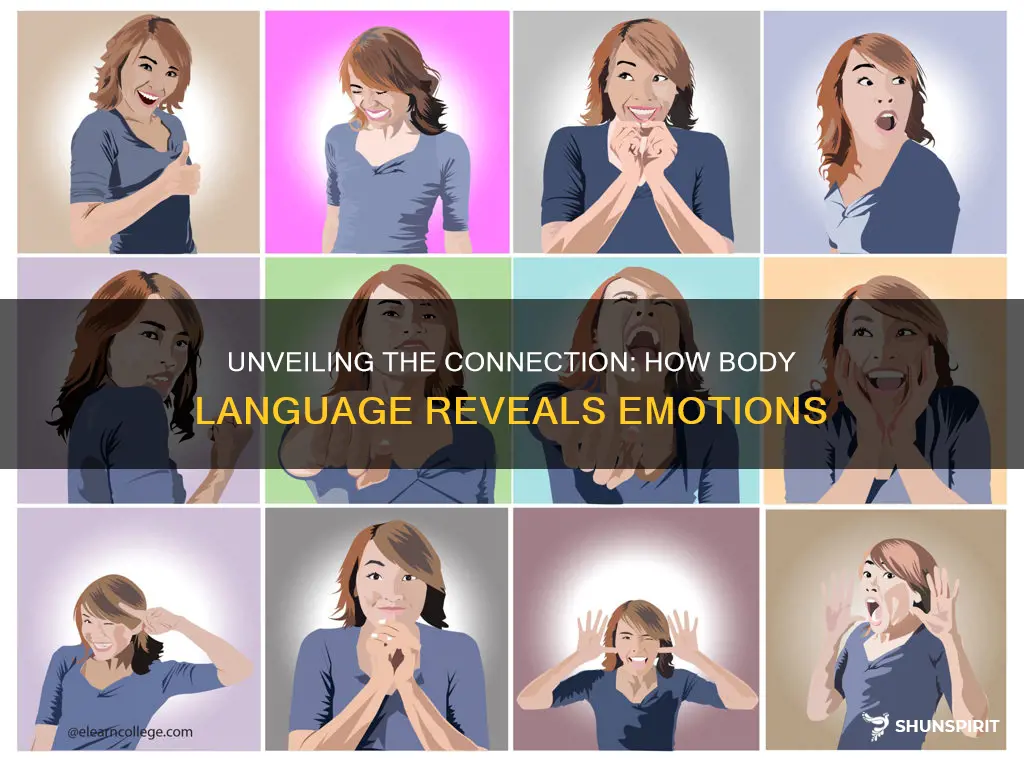
Have you ever wondered how we communicate our emotions without saying a single word? It turns out that our bodies have a language of their own - body language. From the way we stand, to the expressions on our faces, body language can reveal a whole range of emotions, from joy to anger to sadness. In fact, research has shown that body language can often be more powerful than spoken language when it comes to conveying how we truly feel. So, if you've ever had trouble understanding someone's true emotions, paying attention to their body language just might provide you with the answers you're seeking.
| Characteristics of Body Language Showing Emotion | Values |
|---|---|
| Facial expressions | Happy, sad, angry, surprised, disgusted, fearful |
| Eye contact | Avoiding, direct, wide-eyed |
| Gestures | Open palms, pointing, clenched fists |
| Posture | Upright, slouched, crossed arms |
| Hand movements | Nervous, calm, aggressive |
| Body orientation | Facing towards, facing away |
| Smiling | Genuine, forced |
| Tone of voice | Soft, loud, aggressive, soothing |
| Touch | Hug, handshake, pat on the back |
| Breathing patterns | Fast, shallow, deep |
| Perspiration | Sweaty palms, forehead |
| Blushing | Redness in cheeks |
| Pupil dilation | Dilated, constricted |
What You'll Learn

Body Language and Emotion
Body language is a crucial aspect of communication that can convey our emotions and thoughts even when we are not speaking. Understanding and using body language effectively can greatly enhance our ability to connect with others and convey our intentions. In this article, we will explore three important elements of body language: facial expressions, gestures, and posture.
Facial expressions play a significant role in conveying emotions and can be understood universally across cultures. By mastering the art of facial expressions, we can effectively communicate our feelings and intentions to those around us. Here are some key facial expressions and their corresponding emotions:
- Happiness: A genuine smile is one of the most powerful facial expressions. It involves the movement of the muscles around the eyes and the mouth, creating a warm and inviting expression.
- Anger: An angry expression is characterized by furrowed eyebrows, narrowed eyes, and a tense jaw. It conveys displeasure and frustration.
- Surprise: Wide-open eyes, raised eyebrows, and an open mouth are indicative of surprise. This expression conveys a sudden and unexpected event or discovery.
- Sadness: A sad expression is characterized by downturned lips, droopy eyelids, and a downward gaze. It conveys feelings of sorrow, loss, or disappointment.
Gestures are another essential aspect of body language that can enhance our communication. They can be used to emphasize key points, add clarity to our message, and express our emotions. Here are some common gestures and their meanings:
- Nodding: Nodding our head up and down indicates agreement, understanding, or encouragement.
- Pointing: Pointing with our fingers directs attention towards a particular object or person.
- Open palm: Showing our open palms indicates honesty, trustworthiness, and openness.
- Crossed arms: Crossing our arms over our chest can signify defensiveness, disagreement, or a closed-off attitude.
Posture, the way we hold our body, can also communicate a lot about our emotions and attitudes. Here are some important postures and their interpretations:
- Upright and open: Standing or sitting upright with an open and relaxed posture demonstrates confidence, attentiveness, and openness to communication.
- Slouched and closed: Slouching or hunching the shoulders can convey disinterest, fatigue, or a lack of confidence.
- Leaning forward: Leaning forward slightly can indicate interest and engagement in the conversation.
- Arms crossed: Crossing our arms over our chest can signify defensiveness, disagreement, or skepticism.
Understanding and utilizing facial expressions, gestures, and posture effectively can greatly improve our communication skills. Here are some tips to assist you in using these elements of body language more effectively:
- Be aware of your own body language: Monitor your own facial expressions, gestures, and posture to ensure that they align with your intended message.
- Observe others: Pay attention to the body language of those you are interacting with to better understand their emotions and attitudes.
- Practice in front of a mirror: Practice different facial expressions and gestures in front of a mirror to become more comfortable and natural in using them.
- Seek feedback: Ask for feedback from trusted friends or colleagues to gain insights on how your body language is being perceived.
Remember, body language is a powerful tool that can significantly impact our communication and relationships. By mastering the art of facial expressions, gestures, and posture, we can enhance our ability to connect with others, convey our emotions effectively, and build stronger connections.
Recognizing the Signs: Identifying an Emotional Affair and its Impact on Relationships
You may want to see also

Facial Expressions as Emotional Signals
Facial expressions play a crucial role in communicating our emotions to others. From a simple smile to a furrowed brow, our faces can convey a wide range of feelings. In this blog post, we will explore the four main facial expressions commonly associated with specific emotions: smiling and happiness, frowning and sadness, raised eyebrows and surprise, and furrowed brow and anger.
Smiling and Happiness:
Smiling is one of the most recognizable and universal facial expressions of happiness. When we smile, we use the muscles around our mouth to curve our lips upward, and our eyes may also appear brighter and more open. A genuine smile, also known as a Duchenne smile, involves the contraction of the zygomatic major muscle, which raises the corners of our mouths and creates the characteristic "crows feet" around our eyes. Smiling not only signals happiness but can also enhance positive interactions with others, as it conveys warmth, friendliness, and approachability.
To practice smiling, try incorporating small moments of joy into your daily routine. Whether it's reflecting on something that made you happy or simply smiling at a stranger, consciously using your facial muscles to smile can increase your overall feelings of happiness and improve your social interactions.
Frowning and Sadness:
When we frown, our eyebrows come together, and the corners of our mouth turn downward. Frowning is associated with sadness, disappointment, or anger. To portray sadness effectively, it's essential to relax your forehead and let your eyebrows drop slightly, which will create a more realistic expression. Pair your frown with a relaxed and downward-turned mouth to convey a genuine sense of sadness.
If you're struggling with negative emotions, allowing yourself to genuinely express these feelings can be beneficial. By acknowledging and validating your emotions through appropriate facial expressions, you can experience catharsis and potentially open up avenues for healing and seeking support.
Raised Eyebrows and Surprise:
Raised eyebrows often indicate surprise or astonishment. When we're surprised, our eyebrows raise, our eyes widen, and our mouths may open slightly. To convey surprise effectively, practice raising your eyebrows without straining your forehead excessively while maintaining a relaxed facial expression overall. Pair this eyebrow movement with widened eyes, and you'll portray a convincing surprise.
Surprise can add excitement and intrigue to everyday interactions. By incorporating surprise into your communication style through facial expressions, you can create engaging conversations and captivate your audience.
Furrowed Brow and Anger:
Furrowing your brow involves bringing your eyebrows together and down. When we're angry or frustrated, this facial movement helps convey our emotions effectively. Practice furrowing your brow without contracting your forehead too tightly to create a realistic expression. Pair this movement with a tight-lipped or curled-down mouth to express anger or displeasure convincingly.
While expressing anger can be intense, it's important to manage it effectively. Understanding and acknowledging your anger through appropriate facial expressions can help you process this emotion and communicate assertively when needed.
In conclusion, facial expressions are powerful and universal tools for conveying emotions. Smiling and happiness, frowning and sadness, raised eyebrows and surprise, and furrowed brow and anger all play important roles in our interactions with others. By becoming more aware of these facial expressions and practicing them consciously, we can better communicate our emotions, develop stronger connections, and engage with others on a deeper level.
Signs That an Emotional Abuser Has Truly Changed Their Ways
You may want to see also

Gestures and Emotional Communication
Nonverbal communication, particularly gestures, plays a crucial role in conveying emotions and enhancing the effectiveness of spoken words. In this article, we will focus on three aspects of emotional communication: hand movements, crossed arms and defensiveness, and nervous habits and anxiety. Understanding and mastering these nonverbal cues are essential for building strong personal and professional relationships and fostering effective communication.
Hand Movements:
Hand movements are one of the most common and versatile forms of nonverbal communication. They can convey various messages and emotions, emphasizing or supporting the spoken word. Here are some key hand movements and their interpretations:
A. Open palms: Open palms demonstrate honesty, openness, and willingness to communicate. Displaying open palms while talking can be especially beneficial when discussing sensitive topics, as it helps create a safe and trusting environment.
B. Pointing finger: Pointing a finger can indicate assertiveness or aggression, depending on the context and intensity. Be mindful of the cultural variations in the perception of pointing gestures, as they can vary drastically.
C. Handshake: A handshake is a universal gesture that portrays trust, respect, and friendliness. A firm handshake accompanied by direct eye contact can leave a positive impression and foster a sense of connection during social or professional interactions.
Arm Crossed and Defensiveness:
Crossing arms is a common nonverbal cue that often indicates defensiveness or discomfort. Understanding the reasons behind this gesture can help improve communication and alleviate potential misunderstandings. Here's how to interpret crossed arms:
A. Defensive stance: When someone crosses their arms tightly across their chest, it signifies a defensive posture. It can indicate disagreement, defensiveness, or a desire to create a barrier between oneself and others. In such situations, it is crucial to approach the person calmly, create an open and safe environment, and actively listen to their concerns.
B. Cold or discomfort: In certain situations, crossing arms can simply be an attempt to keep warm or a habituated physical posture. It is essential not to jump to conclusions, especially when interpreting gestures in isolation. Assess the context and other accompanying body language cues before drawing any conclusions.
Nervous Habits and Anxiety:
When people experience anxiety or nervousness, they often exhibit specific habits that can reflect their emotional state. Recognizing these cues can help us respond appropriately and provide support. Here are typical nervous habits and their interpretations:
A. Nail-biting: Nail-biting is a common nervous habit that usually signifies anxiety or stress. It is essential to create a supportive environment and encourage open communication to alleviate the underlying causes of anxiety.
B. Fidgeting: Fidgeting, such as tapping fingers or bouncing legs, can indicate nervousness or restlessness. Showing empathy and understanding towards individuals exhibiting such habits can help them feel more at ease and comfortable.
C. Avoiding eye contact: People who feel anxious or uncomfortable often avoid eye contact. Acknowledge this behavior and aim to create a non-threatening environment that encourages open dialogue.
Enhancing emotional communication through gestures is an art that takes time and practice to master. By understanding the meanings behind hand movements, crossed arms, and nervous habits, we can decode nonverbal cues, improve communication, and foster healthier relationships. Remember, being attentive to nonverbal cues, active listening, and providing a supportive environment are key to effective emotional communication.
Raising an Emotionally Intelligent Child: The Amazon Parent's Guide
You may want to see also

Posture and Emotional States
Posture plays a major role in our daily lives, not only in terms of physical health but also in our emotional state. It's fascinating to discover that the way we carry ourselves can have a direct impact on our confidence, energy levels, and overall comfort. In this blog post, we'll explore the connection between posture and emotional states, focusing on the effects of upright posture, slouched shoulders, and closed body language on confidence, fatigue, and discomfort respectively.
Upright Posture and Confidence:
It's no secret that standing or sitting up straight can convey confidence and assertiveness. Research has shown that adopting an upright posture can have a positive impact on our emotional state. When we have good posture, with our shoulders back and our head held high, we instantly feel more self-assured and ready to take on any challenge that comes our way.
Why does this happen? Well, for starters, an upright posture improves our breathing, allowing us to take in more oxygen, which in turn increases our energy levels. Additionally, when we stand tall, our bodies align better, leading to improved blood circulation and muscle engagement, making us feel stronger and more capable.
To boost your confidence through posture, make a conscious effort to stand upright and sit with your back supported and aligned. Imagine a string pulling the top of your head towards the ceiling, elongating your spine. With time and practice, an upright posture will become natural to you, contributing to a positive emotional state and a confident outlook on life.
Slouched Shoulders and Fatigue:
We've all experienced the exhaustion that comes with slouched shoulders and a rounded back. This posture not only affects our physical well-being but also leaves us feeling tired and drained emotionally.
When we slouch, our chest collapses, restricting our lung capacity and limiting the amount of oxygen that reaches our bodies. This lack of oxygen can lead to feelings of fatigue, making it difficult to concentrate and focus on tasks at hand.
Furthermore, slouched shoulders can contribute to muscle imbalances and tension, especially in the neck and upper back. This tension creates discomfort, further draining our energy levels and leaving us feeling fatigued both physically and emotionally.
To combat fatigue caused by slouching, it's important to be aware of our posture and make a conscious effort to correct it. Regularly stretching the chest muscles and strengthening the muscles of the upper back can help improve our posture and alleviate feelings of fatigue. Additionally, taking breaks throughout the day to stretch and walk around can reduce muscle tension and boost energy levels.
Closed Body Language and Discomfort:
Our body language speaks volumes about how we feel, and closed body language can contribute to feelings of discomfort and unease. When we cross our arms, hunch our shoulders, and avoid eye contact, we create a physical barrier that can hinder our ability to connect with others and feel at ease in social situations.
Closed body language not only affects our interactions with others but also impacts our emotional state. By adopting this defensive posture, we send signals to our brain that we are not open to forming connections, leading to feelings of isolation and discomfort.
To break free from closed body language and feel more comfortable in social situations, it's important to be mindful of our posture. By consciously keeping our arms relaxed and our shoulders down, we can create a more open and inviting stance. Additionally, maintaining eye contact and smiling can help us project a friendly and approachable demeanor, putting both ourselves and others at ease.
In summary, posture and emotional states are deeply intertwined. Adopting an upright posture can boost confidence and energy levels, while slouched shoulders can lead to feelings of fatigue. Closed body language can create discomfort and hinder social interactions. By being mindful of our posture and making a conscious effort to maintain an upright and open stance, we can positively impact our emotional well-being and create a more confident and comfortable state of mind. So stand tall, open up, and embrace the power of posture!
A Guide to Writing a Comprehensive Report on Emotional Intelligence
You may want to see also







